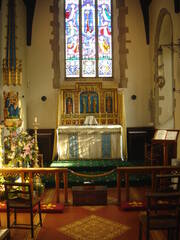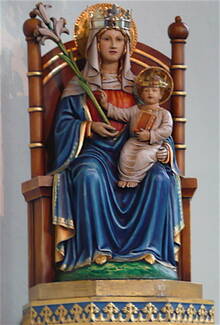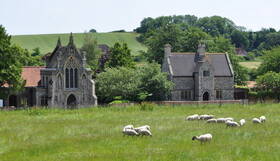Our Lady of Walsingham
The National Shrine of Our Lady in England
Feast day - 24th September
3 2us by Father Ed Tomlinson ![]()
"Today's the feast of Our Lady of Walsingham, calling us to prayer for Christian unity. Why this connection between Mary's appearance in Britain and Christian unity? Because Our Lady's appearance was not accidental but a moment of grace and the start of a chain of events connected to England's conversion which involves, I believe, the implementation of the ordinariate in our day. To better understand, let us travel back together to the day it all started. The year is 1061 and, under a Catholic banner, England is known as Our Lady's dowry and its flourishing like never before. This was a great golden era, a time of renewal: cathedrals are built, churches are erected and they're going to define the landscape for so many different generations. Catholic devotion suits the English people and it leads to a great cultural flowering, producing in my opinion the greatest art, music and architecture that this land has ever seen. And in a tiny Norfolk village we find a noblewoman, Richeldis de Faverches, deep in prayer. To her amazement, the Blessed Virgin appears to her in a vision 3 times, instructing Richeldis to build a replica of the Holy House of Nazareth. Richeldis undertakes this work with obedience and soon a spring of living water is unearthed. Once built, the priory shrine of Our Lady of Walsingham became the beating heart of Catholic England. From all over Europe people flocked, to be healed, to pray, to receive the sacraments, to give devotion to the Lord. Peasants and kings were equal here, in this place of profound grace, miracle and favour."
Paul, from England, a pilgrim to Walsingham ![]()
"It was a time of discovering who Mary is for me in my life at this time because sometimes my relationship with Mary takes a back seat. I found through the 3 days I was there to really enjoy a love for Mary again, to discover the rosary in more depth, to understand her ideas for the world and what her example can be for me today and for the rest of humanity."

The Story of Walsingham
In 1061, Our Lady heard the prayer of a Saxon noblewoman, Richeldis de Faverches, that she might undertake some special work for the Blessed Virgin. In return, Richeldis was presented with a vision of the 'Holy House', the house in Nazareth where the Annunciation took place. Our Lady asked Richeldis to build an exact replica of that house in Walsingham, a small village in Norfolk, England.
After the vision was repeated three times, the house was miraculously constructed one night with materials provided by Richeldis, while Richeldis herself kept a vigil of prayer. ‘England’s Nazareth’ was born, and nearly 1,000 years later, pilgrims still come in large numbers to the shrine of Our Lady of Walsingham.
Walsingham was one of the most popular sites of medieval pilgrimage, with both peasants and royalty flocking faithfully to the Marian shrine. However, Walsingham suffered badly during the Reformation in England, when King Henry VIII, himself formerly a pilgrim to this honoured shrine, gave orders for the shrine to be torn down and the neighbouring priory dissolved. The famous statue of Our Lady of Walsingham, housed in the Holy House since its original construction, was burnt under the accusation of idolatry.
At the turn of the 20th century, a Roman Catholic pilgrimage to the neighbouring Slipper Chapel sparked off an eventual restoration of the Walsingham shrine. Fr Patten, the Anglican Vicar of Walsingham, helped to renew Anglican interest in England’s great Marian shrine and was a pivotal figure in its restoration. A new statue of Our Lady of Walsingham, a replica of the medieval original, was enshrined in the rebuilt Holy House.
Today, Mary’s shrine at Walsingham is aglow with candles lit by Christian pilgrims of various denominations, with both Catholic masses and Anglican services being celebrated in the Holy House. The Slipper Chapel is the center of Catholic prayer and worship in Walsingham, and notably served as one of the sites for the veneration of the relics of St Thérèse of Lisieux in October 2009. The sacraments are again alive at Walsingham, with Eucharistic adoration and confession being revived by the Youth 2000 movement.
Walsingham's intense spiritual atmosphere has to be personally experienced; it is a sign of Mary’s enduring queenship in England, of the healing of our Christian past, and the hope we have for the reconversion of England. Pilgrims can pray ‘Hail Mary’ within walls just like those that echoed to the Angel Gabriel’s own ‘Ave Maria.’
The feast of Our Lady of Walsingham is celebrated on September 24th in England. It was formerly celebrated on March 25th, the feast of the Annunciation.
Written by Erin-Thérèse
Father James Leachman OSB, a Benedictine monk at Ealing Abbey ![]()
"Our Lady of Walsingham has always made a big impression, since my mother took me to the Shrine of Our Lady of Walsingham when I was about 14 (& now I’m 64). I've always asked her prayers and the mother figure is very important to me, the divine motherhood is very important to me. "


